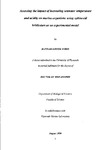Assessing the impact of increasing seawater temperature and acidity on marine organisms using ophiuroid brittlestars as an experimental model
| dc.contributor.author | WOOD, HANNAH LOUISE | |
| dc.contributor.other | Faculty of Science and Engineering | en_US |
| dc.date.accessioned | 2013-10-25T12:13:00Z | |
| dc.date.available | 2013-10-25T12:13:00Z | |
| dc.date.issued | 2009 | |
| dc.identifier | NOT AVAILABLE | en_US |
| dc.identifier.uri | http://hdl.handle.net/10026.1/2388 | |
| dc.description.abstract |
Ocean acidification is a consequence of rapidly increasing atmospheric levels of carbon dioxide and, in tandem with increasing sea temperature, poses a significant threat to marine life. A series of mesocosm experiments have been conducted at the Plymouth Marine Laboratory (Plymouth, UK) and the Kings Bay Marine Laboratory (Ny-Alesund, Svalbard) where ophiuroid brittlestars were used as a model to investigate the physiological response of marine organisms to ocean acidification and ocean warming. A 'whole organism' approach was adopted to elucidate the primary physiological responses, trade offs and conflicts that occurred. Three ophiuroid species of differing lifestyle and habitats were chosen to give an insight into how such factors influenced a species' response to ocean acidification and warming; the infaunal Amphiura filiformis, the epibenthic Ophiura ophiura, both temperate, and the Arctic epibenthic Ophiocten sericeum. There was a similar physiological response of metabolic upregulation across all three species. All species survived the lowest pH exposures (6.8 for A. filiformis, 7.3 for 0. ophiura and 0. sericeum) and showed signs of synergy between increasing water temperature and ocean acidification with the effects of lowered pH amplified as temperature increased. Beyond this, whilst specific responses differed between species, some similarity was observed between the epibenthic species 0. ophiura and 0. sericeum which both reduced arm regeneration and motility at lowered pH. In contrast, A. filiformis increased arm regeneration and suffered arm muscle wastage that appeared unsustainable. Differences in response and long term vulnerability to ocean acidification related to lifestyle (infaunal versus epibenthic) were consolidated by the Energy Limitation Model whereby the response of a species to ocean acidification is based on the increased cost of maintaining the acid-base balance of extracellular fluids. The ability to do this, and where the energy is taken from to do so, rationalises the variety of physiological responses seen between species. The results of the investigations described in this thesis indicate that even species with low regulatory capacity may survive ocean acidification. However, lifestyle may have a determining role in where energy trade offs are made to maintain acid-base balance and this may ultimately determine species survival. | en_US |
| dc.description.sponsorship | Plymouth Marine Laboratory | en_US |
| dc.language.iso | en | en_US |
| dc.publisher | University of Plymouth | en_US |
| dc.title | Assessing the impact of increasing seawater temperature and acidity on marine organisms using ophiuroid brittlestars as an experimental model | en_US |
| dc.type | Thesis | |
| dc.identifier.doi | http://dx.doi.org/10.24382/3400 |
Files in this item
This item appears in the following Collection(s)
-
01 Research Theses Main Collection
Research Theses Main


